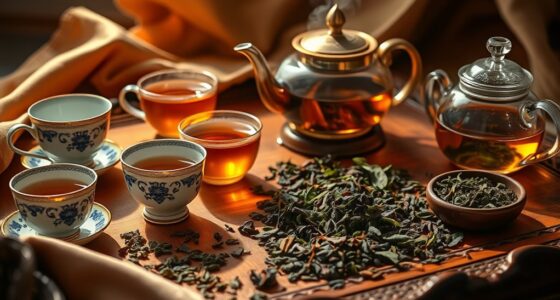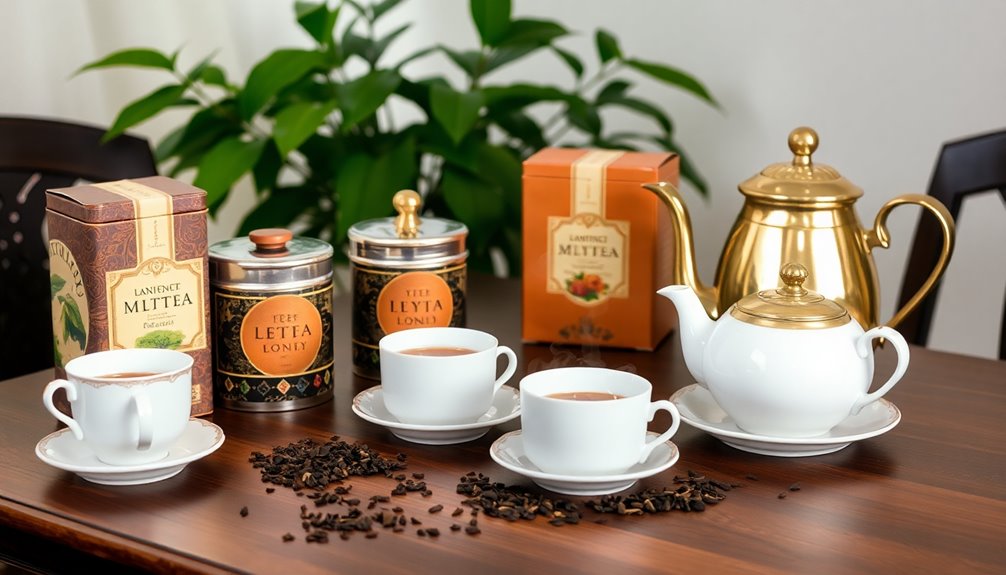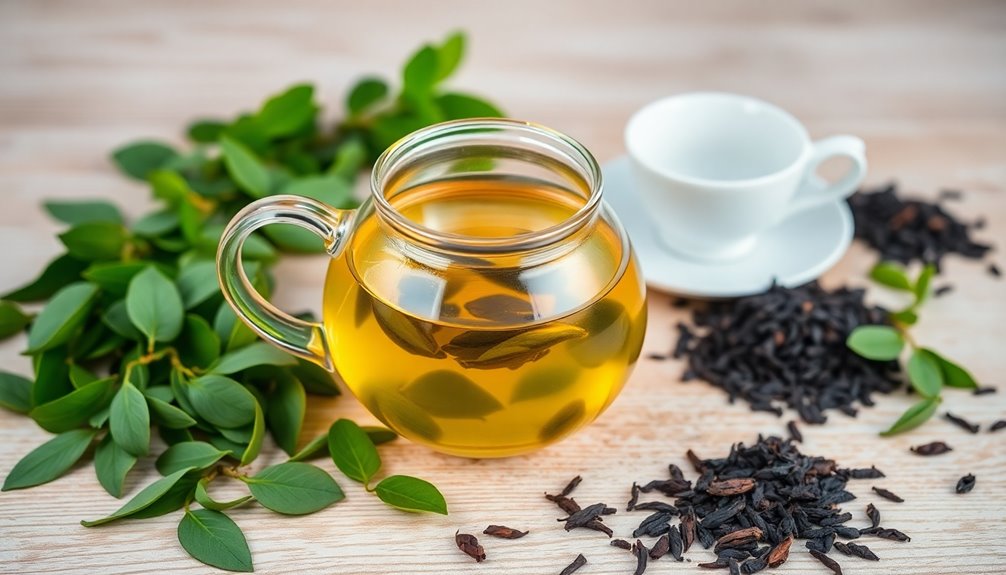If you're curious about tea, you've got some delicious options! Black tea is strong and should brew at 200-212°F for 3-6 minutes. Green tea has a grassy flavor and needs 160-185°F water for 1-3 minutes. White tea is delicate; steep it at 175°F for 2-3 minutes. Oolong tea offers a mix of black and green qualities, and herbal tea is caffeine-free, brewing at 212°F for 5-7 minutes. Use 1-1.5 tablespoons of loose tea per 8 oz of water for the best flavor. There's so much more to discover about tea and its cultural significance!
Key Takeaways
- Black Tea: Brew at 200-212°F for 3-6 minutes using 1-1.5 tablespoons of loose tea per 8 oz of water.
- Green Tea: Brew at 160-185°F for 1-3 minutes to enjoy its grassy notes and antioxidant benefits.
- White Tea: Steep at 175°F for 2-3 minutes for a delicate flavor and lower caffeine content.
- Oolong Tea: Combine qualities of black and green tea; steeping times vary based on desired flavor strength.
- Herbal Tea: Brew at 212°F for 5-7 minutes, offering diverse flavors without any caffeine.
Introduction
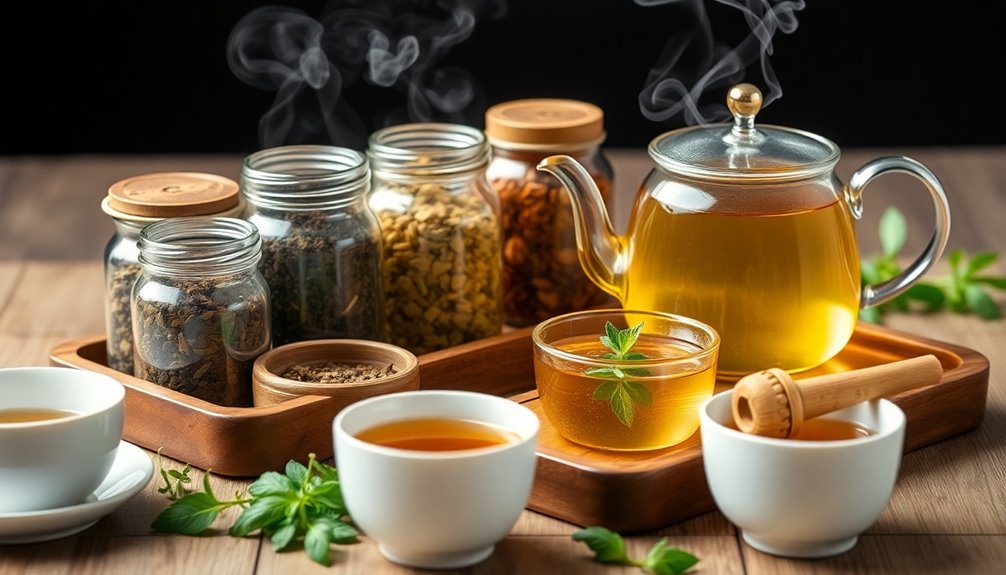
When you think about tea, it's easy to get lost in the myriad of options available today. Each type of tea offers something special, whether you're sipping on black tea, green tea, white tea, oolong, or herbal teas.
Black tea's strong flavor and higher caffeine content make it a popular choice for a morning boost. You'll want to brew it with boiling water at temperatures between 200-212°F for about 3-6 minutes to get that perfect cup.
If you prefer something lighter, green tea is celebrated for its grassy notes and powerful antioxidants. It's best brewed at lower temperatures, around 160-185°F, for 1-3 minutes.
For those who enjoy subtle flavors, white tea is the most delicate and should be steeped at 175°F for 2-3 minutes.
Let's not forget herbal teas! These caffeine-free options can include various herbs and spices, providing a unique flavor experience. Boil your water to 212°F and steep herbal teas for about 5-7 minutes.
With the right brewing methods and steeping time, you'll discover the delightful world of teas and how to enjoy each one to its fullest!
Tea's Global Cultural Significance
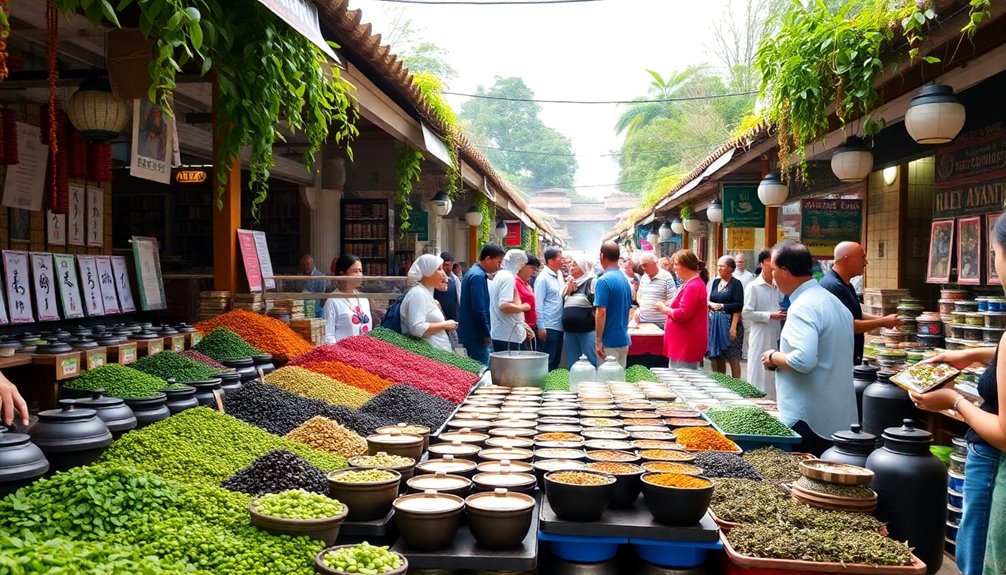
Tea isn't just a beverage; it carries profound cultural significance across the globe. Different cultures celebrate tea in unique ways, creating rich tea culture traditions.
For instance, the Japanese tea ceremony, known as Chanoyu, highlights harmony and respect, allowing you to appreciate every sip. In China, tea is deeply rooted in history, with the Camellia sinensis plant being a central part of social interactions for over 5,000 years.
When it comes to popular types of tea, green and black teas often take the spotlight. Afternoon tea in Britain, introduced in the early 19th century, has become a cherished social event, featuring loose-leaf tea alongside delightful sandwiches and pastries. It's a perfect moment for relaxation and conversation.
In many cultures, offering tea symbolizes hospitality and friendship. You'll find different brewing methods and rituals that enhance the experience, whether you enjoy herbal tea or prefer the classic varieties.
Understanding these traditions can deepen your appreciation for tea, turning every cup into a celebration of connection and culture. So, next time you brew a cup, think about the rich history and meaning behind it!
Tea's Health Benefits Explored
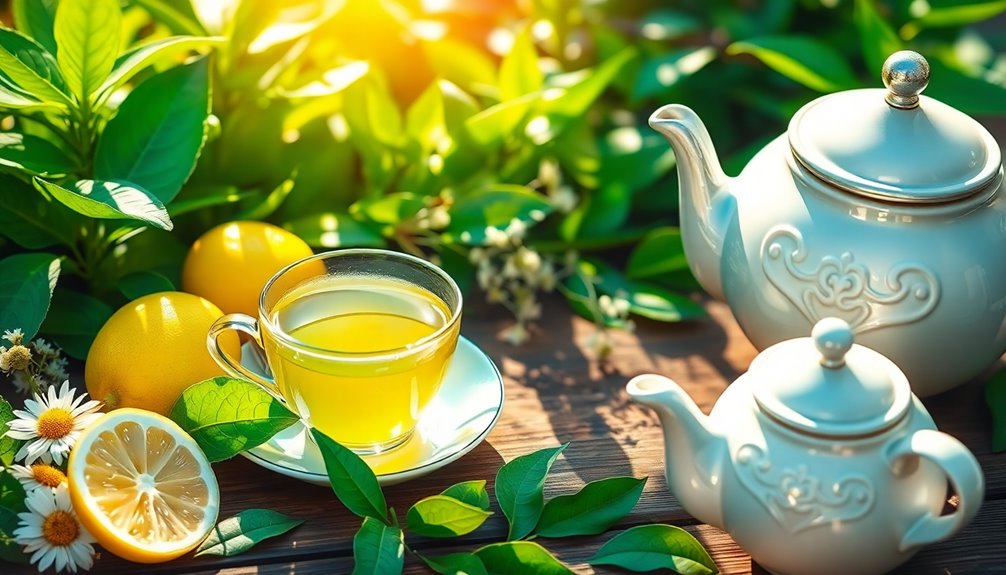
How can a simple cup of tea contribute to your well-being? When you sip on your favorite teas, you're not just enjoying a tasty drink; you're also reaping some amazing health benefits!
For instance, green tea is loaded with antioxidants called polyphenols. These can help reduce the risk of chronic diseases like heart disease and cancer. Plus, drinking green tea regularly might boost your brain function and lower the risk of neurodegenerative diseases. Additionally, the preparation of green tea often emphasizes mindfulness and respect, which can enhance the overall experience and promote relaxation.
On the other hand, black tea can support heart health. Studies show it may lower blood pressure and cholesterol levels, making it a smart choice for your heart.
If you need to unwind, herbal teas like chamomile and peppermint are your best pals. They can aid digestion and promote relaxation, helping you to relieve stress and improve your sleep quality. Additionally, incorporating rooibos tea into your routine can offer unique health benefits, such as anti-inflammatory properties.
Don't forget about rooibos tea! It's caffeine-free and packed with minerals like calcium and magnesium, which can support bone health. Additionally, the caffeine content in tea is generally lower than in energy drinks, making it a gentler option for those sensitive to stimulants.
Tea's Role in Ceremonies
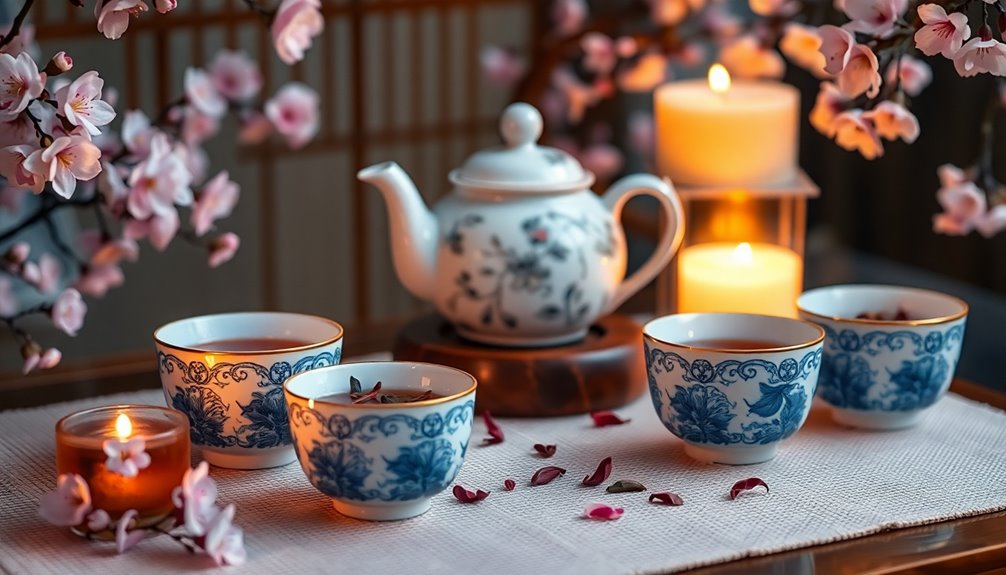
Sipping tea can also open the door to rich cultural traditions and ceremonies that highlight its significance beyond just a beverage. One of the most famous is the Japanese tea ceremony, or Chanoyu. Here, you'll find a focus on mindfulness and the beauty of serving and drinking tea. It involves intricate rituals and specific utensils, making every sip special.
In Chinese culture, the Gong Fu Cha ceremony showcases the art of brewing tea. This practice emphasizes skillful preparation, allowing you to enjoy multiple steepings from the same leaves.
Then there are Indian chai ceremonies, where boiling black tea with spices and milk symbolizes hospitality during social gatherings. It's all about comfort and warmth shared with friends.
In Tibet, tea ceremonies often include butter tea, or po cha, mixed with yak butter and salt, reflecting the tea's cultural importance in daily life.
Across many cultures, from Moroccan to British, tea rituals foster community and connection.
Caffeine Content Debates

Caffeine content in various tea types sparks lively debates among enthusiasts and casual drinkers alike. When it comes to true teas, black tea usually takes the crown for caffeine levels, containing about 40 to 70 mg per 8 oz cup. Green tea has less, ranging from 20 to 45 mg. If you prefer something lighter, white tea is your friend, with only 15 to 30 mg. Brewing techniques can also influence how much caffeine is extracted from the leaves, with steeping time being a crucial factor.
Many tea drinkers love herbal teas, like chamomile and peppermint, which are caffeine-free, making them perfect for those sensitive to caffeine. Additionally, antioxidants found in tea can provide health benefits similar to those of coffee.
But the caffeine content can vary based on several factors. For instance, brewing time and water temperature play a significant role. If you steep black tea longer or use hotter water, you'll get more caffeine. This leads to discussions on the best ways to brew different types of teas. Some argue for longer steeping times, while others advocate for lower temperatures. The fun lies in experimenting to find your ideal brew! Additionally, understanding brewing techniques can enhance your tea experience by maximizing flavor and health benefits.
Practical Applications
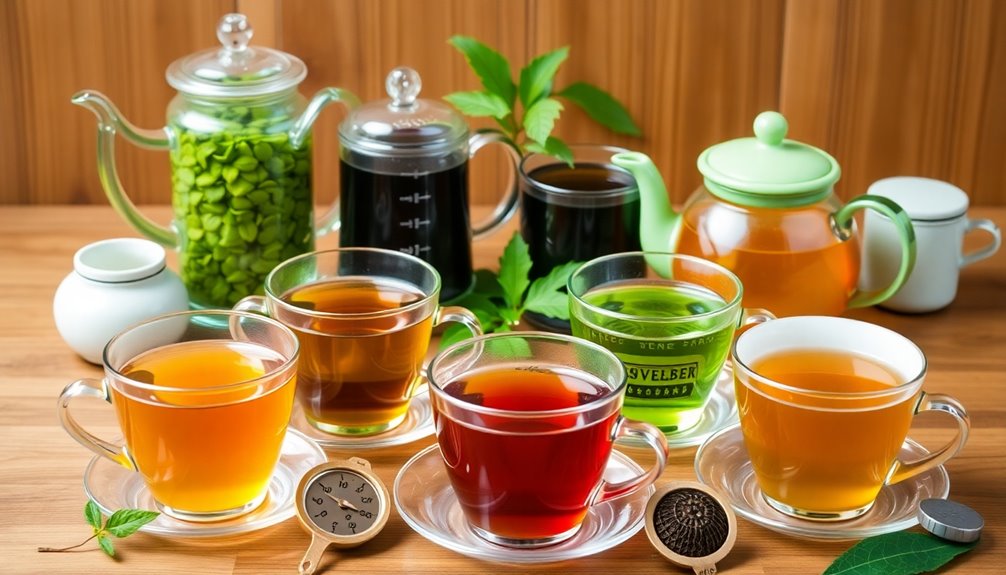
When it comes to brewing tea, understanding the practical applications of water temperature, steeping time, and leaf quantity can significantly enhance your experience. Each type of tea requires specific conditions to bring out its best flavor.
For example, to brew black tea, heat your water to 200-212°F, while green tea loves a cooler range of 160-185°F.
Steeping time is just as important. Black tea usually needs 3-6 minutes, whereas white tea is ready in just 2-5 minutes. The right leaf quantity also matters; aim for 1-1.5 tablespoons of loose tea per 8 oz of water for both black and oolong teas.
Don't forget about brewing equipment! Using a teapot, infuser, or French press can help extract those delicious flavors effectively.
If you're brewing green or oolong, try multiple infusions. The first brew is often robust, but the second and third can reveal different tastes with shorter steeping times.
Frequently Asked Questions
What Type of Tea Is the Most Popular?
You'll find that black tea is the most popular type globally, making up about 75% of tea consumption. Its robust flavor and versatility in brewing have contributed to its widespread appeal among tea drinkers.
What Are the 6 General Kinds of Tea?
You'll find six general kinds of tea: white, green, oolong, black, herbal, and rooibos. Each type offers unique flavors and benefits, making your tea experience diverse and enjoyable no matter what you choose.
What Are the 5 Types of Tea?
You'll find five main types of tea: white, green, oolong, black, and herbal. Each type offers unique flavors and characteristics, providing you with a delightful variety to enjoy in your daily routine.
Which Is the Tastiest Tea in the World?
When it comes to the tastiest tea, it really depends on your palate. You might find Darjeeling's muscatel flavor enchanting, while others prefer the umami richness of matcha or the floral notes of jasmine.
Conclusion
Now that you know about different tea types and how to brew them, it's time to enjoy your perfect cup! Remember, each tea has its own unique flavor and benefits. Whether you're sipping green tea for energy or black tea for a cozy moment, there's a brew for every occasion. So grab your kettle, pick your favorite tea, and start brewing. You're all set to explore the wonderful world of tea! Happy sipping!




